
The Gateway of India is an arch-monument completed in 1924 on the waterfront of Mumbai (Bombay), India. It was erected to commemorate the landing of George V for his coronation as the Emperor of India in December 1911 at Strand Road near Wellington Fountain. He was the first British monarch to visit India.

The University of Mumbai is a public state university in Mumbai. It is one of the largest university systems in the world with over 549,000 students on its campuses and affiliated colleges. As of 2013, the university had 711 affiliated colleges. Ratan Tata is the appointed head of the advisory council.

Elphinstone College is one of the constituent colleges of Dr. Homi Bhabha State University, a state cluster university. Established in 1856, it is one of the oldest colleges in Mumbai. It played a major role in shaping and developing the educational landscape of the city. It also played a pivotal role in the inception of the University of Mumbai.
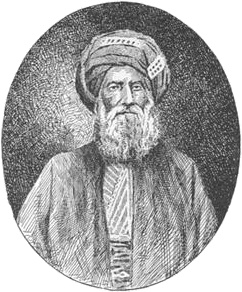
David Sassoon was the treasurer of Baghdad between 1817 and 1829. He became the leader of the Jewish community in Mumbai after Baghdadi Jews emigrated there.

Fort is a business and art district in the city of Mumbai, Maharashtra, India. The area gets its name from the defensive fort, Fort George, built by the British East India Company around Bombay Castle.
The Wadia family is a Parsi family from Surat, India currently based in Mumbai, India. The family rose to wealth in the mid-1700s as shipbuilders serving the British East India Company as the latter established its sway over India.
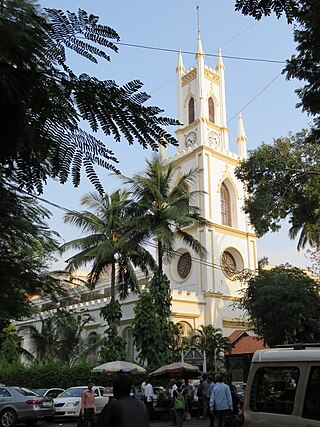
St. Thomas Cathedral, Mumbai, is the 300-year old cathedral church of the Anglican Diocese of Mumbai of the Church of North India. It is named in honour of Saint Thomas the Apostle, who is believed to have first brought Christianity to India. The cathedral is located in Horniman Circle, the historic centre of Mumbai. It is in close proximity to famous Mumbai landmarks such as Flora Fountain and Bombay House. It is the oldest church in Mumbai The Cathedral and John Connon School is run by the cathedral.

Sir Dinshaw Maneckji Petit, 1st Baronet was an Indian entrepreneur and founder of the first textile mills in India, as well as a great philanthropist. He was part of the Petit family and became the first Petit baronet.

The David Sassoon Library and Reading Room is a famous library and heritage structure in Mumbai, India. The idea for a library to be situated in the center of the city came from Albert Sassoon, son of the famous Baghdadi Jewish philanthropist, David Sassoon.
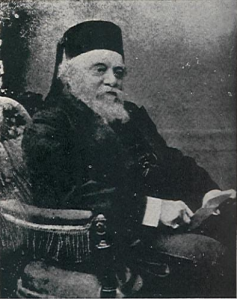
Ardaseer Cursetjee Wadia FRS was an Indian Parsi shipbuilder and engineer belonging to the Wadia ship building family.

Dadabhai Naoroji Road (D.N.Road), a North–South commercial artery road, in the Fort business district in South Mumbai of Maharashtra, India, is the nerve centre of the city, starting from the Mahatma Phule Market ,linking Chhatrapati Shivaji Maharaj Terminus, leads to the Hutatma Chowk at the southern end of the road. This entire stretch of the road is studded with Neo–Classical and Gothic Revival buildings and parks built in the 19th century, intermingled with modern office buildings and commercial establishments.
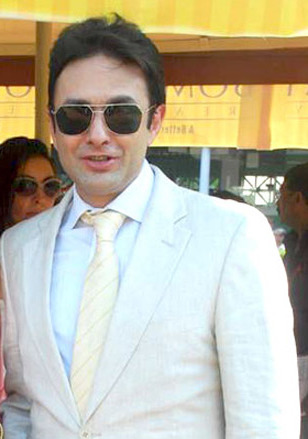
Ness Nusli Wadia is an Indian businessman. Wadia is the managing director of Bombay Burmah Trading Corporation, a company which has holdings in most of the Wadia Group subsidiaries, including an indirect majority stake in Britannia Industries. He was the Joint Managing Director of Bombay Dyeing, the flagship company of the Wadia Group, till March 2011 when he stepped down from the post. Wadia is a co-owner of the Indian Premier League cricket team Punjab Kings.
The architecture of Mumbai blends Gothic, Victorian, Art Deco, Indo-Saracenic & Contemporary architectural styles. Many buildings, structures and historical monuments remain from the colonial era. Mumbai, after Miami, has the second largest number of Art Deco buildings in the world.
UNESCO Asia Pacific Heritage Awards are given with as the strategic purpose of UNESCO with in the region Asia Pacific. The objective is to motivate the protection of Cultural Heritage sites, which are initiated by any individual organization under private sector or institutional organization.

The Victorian Gothic and Art Deco Ensembles of Bombay is a collection of 19th-century Victorian Revival public and 20th-century Mumbai Art Deco private buildings in the Fort precinct of Mumbai. This ensemble was declared a UNESCO World Heritage Site in 2018.
B.D. Petit Parsee General Hospital is a hospital in Cumballa Hill, Mumbai.

Christ Church in Byculla, Mumbai, is affiliated to the Church of North India and was built in 1833 as an Anglican church. The church's establishment has been the subject of a myth that it was built to suit the convenience of the Governor of Bombay, Mountstuart Elphinstone, who reportedly had to earlier travel from his central Bombay residence in Parel to St Thomas Cathedral in South Bombay. Elphinstone had already left India in 1829. The church was, in fact, built during the governorship of John FitzGibbon, 2nd Earl of Clare, who laid the foundation stone in July, 1832.
Vikas Dilawari is an Indian conservation architect who has restored at-risk monuments and heritage buildings in Mumbai, including the Victoria Terminus, Rajabai Clock Tower, Dr. Bhau Daji Lad Museum, Wellington Fountain and Christ Church, Byculla. 16 restoration projects carried out by his team have been recognised by the UNESCO Asia-Pacific Awards for Cultural Heritage Conservation, including the 2019 work on the Flora Fountain, which was designed by architect Richard Norman Shaw and completed in 1864.

Wellington Fountain is a listed heritage structure in front of Maharashtra Police Headquarters at Shyamaprasad Mukherjee Chowk in Fort, Mumbai, which is part of Mumbai's Victorian ensemble that is a UNESCO World Heritage Site. It was erected in 1865 to commemorate the visits of Arthur Wellesley, 1st Duke of Wellington, who came to India in 1801 and 1804.
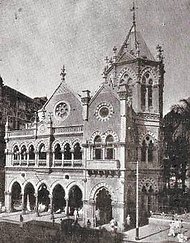
The J. N. Petit Library is a membership library in a Grade II heritage structure in Fort, Mumbai. It was founded in 1898 by a group of Parsi students studying at Elphinstone College. Membership is open to residents of Mumbai.

















